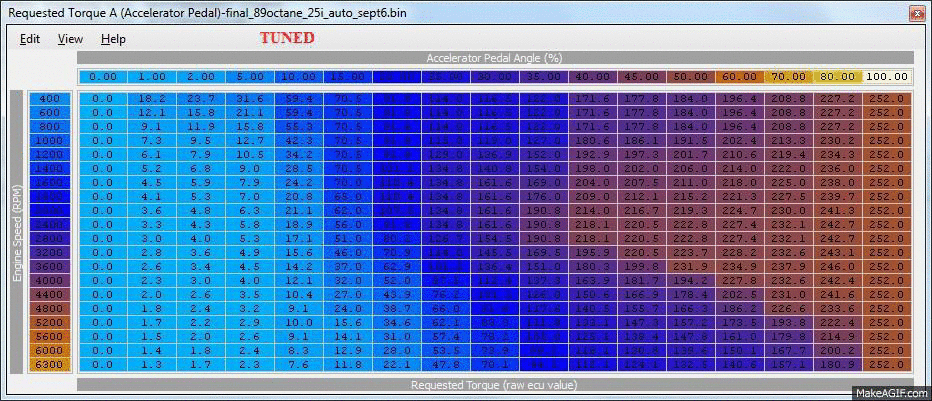Background:
For those of you who are unfamiliar with Drive by wire throttles (DBW), they are basically 'electric' throttles. The computer in your machine (ECU) determines how much the throttle plate should be open based on several conditions including the accelerator pedal position. Almost all new cars have a drive by wire system now. DBW systems are often Not linear in function compared to traditional cabled throttles and DBW accelerator pedasl do Not directly control the throttle plate.
Issue:
My factory throttle mapping for my subaru was always a pain in my butt. After buying this car I started to sorely miss my cabled throttle in my old Honda. This Subaru Drive By Wire throttle (DBW) is so sensitive (presumably to attract buyers at testdrives) that I would accidentally go WOT at sometimes only 20% pedal travel. So an example: using scangauge, while accelerating, I would try to maintain 70% engine load at 2000rpm. but when transmission would shift all of a sudden my engine load (manifold pressure) would jump to 99%. This was because Subaru programmed for more throttle opening at lower pedal travels for lower engine speeds. This caused poor gas mileage in the city and I could accidentally use more throttle than I needed when hypermiling in traffic. Unwanted acceleration, a jerky drive and a fatigued foot were causing problems.
Solution:
I was desperate for a drive by wire tune for a more linear feel, at least for the first 1/4 of throttle travel. After much research and reading I learned to use an opensource Subaru tuning software to design my own Maps. I used a guide from a Subaru fan site and adjusted my DBW until I was satisfied.
Here are the drive by wire maps - before and after:

*I don't want to bore you with the technicals so skip this paragraph if you are not interested. Basically in the map above lower values 'could' mean less throttle plate opening, but note these values are checked against another table which determines how much requested torque means exactly how much throttle plate opening for every RPM. So >120 requested torque at 1500rpm could mean WOT while you will need at least 200 requested torques to open the throttle plate wide at 2500rpm. It's a 3D map.
Results:
WOW! Not only did my driving experience become silky smooth but engine Load stays very close after shifts. No more spikes in manifold pressure and unwanted accelerations. I really feel sorry for owners who are stuck with crappy factory tuned DBW throttles. Also when cruising it's very easy to feather the throttle to put the engine in its 'sweet spot'. So far for the past month I gained about ~3mpg in my city driving which is a massive improvement to my dismal 23mpg. The only downside is that the torque converter unlocks easier now since there is more pedal travel now. This has to do with TCU which I am not able to manipulate. Also engine load can fall to pretty low levels during acceleration if you're not careful which can induce pumping losses. But for experienced drivers armed with vacuum gauges, this is not an issue.
a graph to illustrate the change (red line is the new requested torque vs. stock black dots):

please note 'load' in this context is actually "absolute load"
Now at reasonable engine speeds <3000rpm and reasonable accelerator pedal positions <30%, the throttle response is almost linear. Above 30% accelerator pedal things start to pick up quickly. This was kept so to prevent pumping losses and throttle response problems.